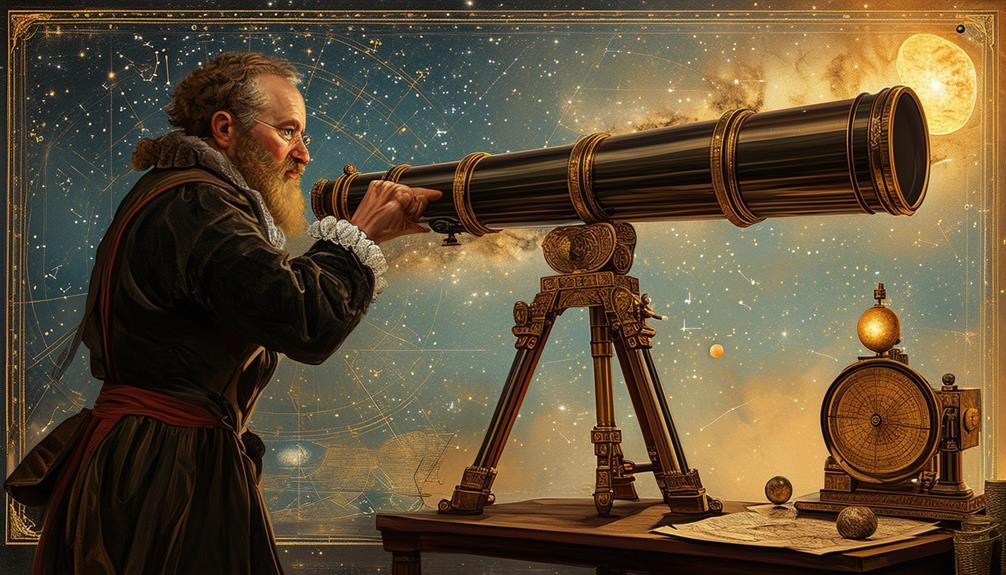Tycho Brahe's Observations and Their Influence on Modern Astronomy

Tycho Brahe's observations form the cornerstone of modern astronomy. His meticulous approach, exemplified by the 1572 nova and the 1577 comet, challenged the Ptolemaic system and set the stage for revolutionary ideas.
One might wonder how his precise measurements and innovative instruments influenced Johannes Kepler's laws of planetary motion. Brahe's contributions extend beyond historical significance, continuing to impact contemporary celestial observation techniques.
What aspects of his work still resonate in current astronomy, and how did his rigorous data collection shape future breakthroughs?
Tycho Brahe's Key Observations
In 1572, Tycho Brahe observed a new star in the constellation Cassiopeia, challenging the prevailing belief in the unchangeability of the heavens. This new star, or nova, was a significant celestial phenomenon. Brahe's precise measurements of the nova's position revealed no parallax, indicating it was much farther away than previously thought. This finding contradicted the Aristotelian view that the heavens were constant and unchanging.
This new star, or nova, was a significant celestial phenomenon. Brahe's precise measurements of the nova's position revealed no parallax, indicating it was much farther away than previously thought. This finding contradicted the Aristotelian view that the heavens were constant and unchanging.
In addition to his observations of the nova, Brahe also documented a bright comet in 1577. His detailed data collection on the comet transformed the understanding of celestial bodies and their motions. Unlike previous astronomers, Brahe meticulously recorded the comet's path, demonstrating it moved through the heavens without being impeded by any supposed crystalline spheres.
His detailed data collection on the comet transformed the understanding of celestial bodies and their motions. Unlike previous astronomers, Brahe meticulously recorded the comet's path, demonstrating it moved through the heavens without being impeded by any supposed crystalline spheres.
Brahe's commitment to precise measurements and accurate observations laid a robust foundation for future advancements in astronomy. His work provided crucial data that later astronomers, including Johannes Kepler, used to develop more accurate models of the universe. By challenging existing notions and emphasizing empirical data collection, Brahe profoundly shaped the trajectory of modern astronomy. His key observations underscore the importance of thorough scientific inquiry.
Impact on Astronomical Theory
Tycho Brahe's groundbreaking observations fundamentally challenged and reshaped established astronomical theories. His precise observations of the 1572 nova contradicted the Aristotelian belief in an unchanging cosmos. By meticulously charting stellar and planetary positions, Brahe provided a solid empirical foundation previously lacking in astronomy.
Brahe's geo-heliocentric model, which placed a stationary Earth at the center of the universe with the planets orbiting the Sun, attempted to reconcile the Ptolemaic and Copernican systems. His conclusion of a stationary Earth stemmed from his inability to detect stellar parallax, which he interpreted as evidence against the Earth's motion.
Furthermore, Tycho Brahe's observational instruments, such as the mural quadrant, enabled unprecedented precision in astronomical measurements. These accurate observations were crucial for Johannes Kepler, whose laws of planetary motion were significantly influenced by Brahe's data.
Essentially, without Brahe's detailed and precise data, Kepler mightn't have formulated his revolutionary theories.
Development of Astronomical Instruments

Tycho Brahe's development of advanced astronomical instruments, such as the mural quadrant and sextant, significantly improved the precision of celestial observations. By inventing tools like the azimuthal quadrant, Brahe ensured that astronomical measurements were more accurate than ever before. His Great Globe and Armillary Sphere were instrumental in mapping the positions of celestial bodies and enhancing the overall understanding of planetary movements.
These instruments allowed Brahe to make detailed observations of significant celestial events, including the 1572 nova and the 1577 comet. The accuracy of his observations enabled him to propose the geo-heliocentric model, which challenged existing theories of the cosmos.
Brahe's meticulous design and use of these instruments not only revolutionized his era but also laid the groundwork for modern observational astronomy.
Influence on Future Astronomers
Tycho Brahe's meticulous observations and innovative instruments established a crucial foundation for future astronomers, notably Johannes Kepler, who used Brahe's precise data to develop his laws of planetary motion. These laws surpassed the Ptolemaic system and enriched the Copernican theory with accurate models.
Brahe's Tychonic system, which integrated elements of both the Ptolemaic and Copernican theories, played a vital role in advancing astronomical thought. His comprehensive star catalog and advancements in observational instruments set new standards for accuracy, proving invaluable for subsequent research.
By carefully documenting celestial events, such as the 1572 nova and the 1577 comet, Brahe challenged prevailing astronomical beliefs and laid the groundwork for modern discoveries. His legacy of precise data collection and collaboration continues to inspire advancements in astronomy today.
Key aspects of Brahe's influence include:
- Johannes Kepler: Utilized Brahe's data to formulate the laws of planetary motion.
- Tychonic System: Combined traditional and contemporary theories, facilitating the evolution of astronomical thought.
- Star Catalog: Established new benchmarks in observational accuracy.
- Instrument Innovations: Revolutionized methods of celestial observation.
- Modern Discoveries: Built upon Brahe's foundational work, influencing contemporary astronomy.
Legacy and Continuing Relevance

Modern astronomy owes much to the meticulous observations and innovative techniques pioneered by Tycho Brahe. His detailed data collection and observational methods laid the foundation for contemporary astronomy. Brahe's contributions are immense, particularly his geo-heliocentric model, which, despite its inaccuracies, spurred future astronomical advancements.
Brahe's precise data enabled Johannes Kepler to formulate his groundbreaking laws of planetary motion, significantly advancing our understanding of celestial mechanics. This collaboration underscores Brahe's enduring legacy in modern astronomy. Today, his observational methods continue to guide astronomers, who rely on his thorough records to study celestial phenomena.
Here's a summary of Tycho Brahe's lasting impact:
| Aspect | Continuing Relevance |
|---|---|
| Data Collection | Foundation for Kepler's laws; ongoing influence in research |
| Observational Techniques | Basis for modern observational methods |
| Geo-heliocentric Model | Historical significance in astronomical model development |
| Influence on Kepler | Enabled the formulation of the laws of planetary motion |
| Modern Astronomy Impact | Continued use of his data and methods in current studies |
Brahe's contributions remain crucial, demonstrating the lasting impact of his work on modern astronomy. His legacy is a testament to the importance of precise, systematic observations in furthering our understanding of the universe.
Conclusion
Tycho Brahe's acute observations and groundbreaking instruments revolutionized astronomy. His meticulous data collection enabled Kepler to formulate his pioneering laws of planetary motion, fundamentally altering our understanding of celestial mechanics.
Brahe's influence extends beyond history, continuing to inspire modern observational techniques and astronomical research. By challenging established beliefs, he paved the way for numerous scientific breakthroughs.
Tycho Brahe's legacy endures, demonstrating that precise observation can transform our perception of the universe.




